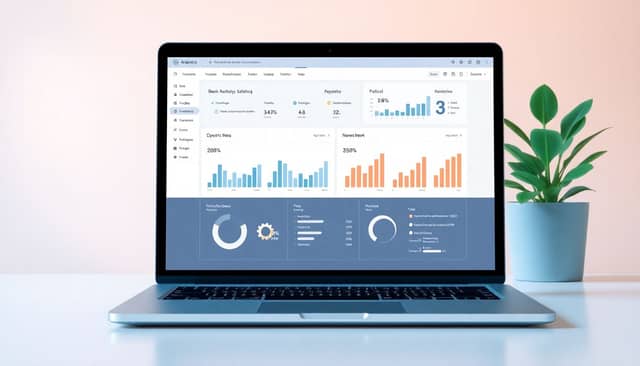Table of Contents
Want to sell more books? It’s normal to feel overwhelmed by how to get your work noticed. Luckily, there’s a tool that can help—book marketing software. Keep reading, and you’ll see how it can make promoting your book easier and more effective, saving you time and stress.
If you stick with me, you’ll find out which top tools are worth trying in 2025 and how to choose the right one for you. Plus, I’ll share simple tips to get the most out of your marketing efforts and resources that can help boost your sales.
So, let’s dive into how these software tools can turn your book promotion from a hassle into a success story.
Key Takeaways
– Book marketing software acts as your virtual assistant, helping you promote and sell your books efficiently across digital platforms. It saves time, keeps your efforts consistent, and can boost sales by making campaigns more targeted. Using the right tools in 2025, like email platforms, social media schedulers, and sales trackers, helps you reach more readers without overwhelm. Focus on automation, analytics, and integrations to make your marketing smarter. Choosing software aligned with your goals, budget, and skills makes promotion easier and more effective, turning book marketing into a manageable part of your publishing journey.

What Is Book Marketing Software and Why You Need It Now
Book marketing software refers to tools designed to help authors and publishers promote, sell, and manage their books more effectively across digital channels. Think of it as your marketing assistant that handles emails, social media posts, sales tracking, and promotional campaigns all in one place.
In today’s fast-growing book landscape—where the global market size is expected to hit over USD 142 billion by 2025—staying ahead means leveraging the right tools. These softwares save you time, streamline your marketing efforts, and can even increase your book sales by making promotional strategies more targeted and consistent.
For example, software like ebook marketing platforms or social media schedulers can help you reach more readers without drowning in manual work. Plus, with the rise of e-books, audiobooks, and online book stores, having a good software setup is essential to stand out and succeed in a crowded market.
Top Book Marketing Software in 2025: Key Tools and Their Features
As 2025 rolls around, several software options stand out for their features and ease of use. Popular tools include BookFunnel for distributing books, Mailchimp or similar email platforms for building your reader list, and social media tools like Hootsuite to handle your posts. These tools allow you to run email campaigns, connect with readers, and track sales all from a dashboard.
Features to look for in these tools include automation (scheduling posts or emails), analytics (seeing what works), and integrations (connecting with platforms like Amazon or Goodreads). Many softwares also offer budget-friendly plans, so you won’t need a big budget to start.
For instance, marketing analytics tools such as Whatagraph integrate data from multiple channels, helping you see what’s driving your sales and where to focus next.
How to Pick the Right Book Marketing Software for Your Goals
Figuring out the best software for your needs begins with setting clear goals. Want to grow your email list? Look for tools with good automation features like email marketing platforms. Need to sell more e-books? Focus on tools that integrate with Amazon or other online stores.
Next, consider your budget and technical skills. If you’re new to marketing, opt for user-friendly options with plenty of tutorials, like simpler all-in-one platforms. If you’re comfortable with analytics, go for more advanced tools that help you fine-tune your campaigns.
Another tip: check if the software offers insights into your audience—knowing who reads your books helps you tailor your marketing. And don’t forget to see if it supports the formats you’re working with, such as e-books or audiobooks. This way, the tool becomes an extension of your goals, not a distraction.

7. How Book Marketing Software Is Shaping the Market in 2025
The book industry is seeing a shift with marketing software playing a bigger role than ever.
In 2025, the global book market is projected to reach nearly USD 143 billion, with digital formats like e-books and audiobooks making up a growing share—about 12% of total trade sales in the US alone [1][3].
This growth fuels the need for authors and publishers to use smart tools to stand out in a crowded scene.
Marketing software tools like ebook marketing platforms and social media schedulers such as Hootsuite help creators connect with their audience more consistently.
These tools allow creators to automate posts, analyze what works best, and reach readers across multiple channels at once.
Data-driven platforms like Whatagraph offer insights into sales trends and audience preferences, encouraging smarter marketing moves.
As the online book services market grows—from an estimated $23.1 billion in 2024 to $24.7 billion in 2025—having the right software can give you a real edge [5].
Authors who adopt these tools early on enjoy better targeting, reduced manual work, and more time to write.
So, it’s no longer just about good stories; effective marketing takes a place alongside them.
Using these tools smartly can mean the difference between a good book and a bestseller in today’s scene.
8. Making the Most of Your Book Marketing Software: Tips and Tricks
If you want to get the best bang for your buck, start by setting clear goals—whether that’s building your email list, selling more e-books, or increasing your social media presence.
Choose software that aligns with those goals—don’t sign up for a big package if all you need is email automation.
Once you’ve picked your tools, spend time learning their features—most offer tutorials, webinars, or even quick guides, like those found on popular all-in-one platforms.
Automate repetitive tasks: scheduling social media posts a week ahead can save you hours each day.
Use analytics to see what posts or emails get the most engagement—then focus your energy there.
A good trick is to repurpose content: turn a blog post into a social media thread, or create snippets from your book for promotional emails.
Don’t forget to track your results—every software makes it easy to see open rates, click-throughs, or sales spikes—so watch and learn.
Finally, stay updated with new features or integrations—sometimes a small upgrade can dramatically boost your results.
By integrating these tips, your marketing automation becomes less of a chore and more of an effective sales partner.
9. Resources Outside Software to Grow Your Book’s Reach
Tools are great, but other resources can boost your chances too.
Joining writer communities online, like those on author forums or Facebook groups, gives you support and ideas.
Building your own website with tools like professional author sites helps you control your brand and contact readers directly.
Getting reviews on platforms like Goodreads or BookBub can increase visibility—think of them as social proof for new readers.
Running promotional campaigns with discounted or free giveaways on sites such as BookBub can bring a spike in interest.
Networking with bloggers or influencers in your genre can put your book in front of a new audience.
Also, consider submitting your book for awards or features on popular newsletters—both open doors to new readers.
Using media mentions and press releases boosts credibility and can lead to coverage in online publications.
Don’t overlook the power of podcasts or interviews—being a guest can introduce your work to fresh audiences.
Mixing these resources with your software tools makes for a well-rounded approach to growing your book’s reach.
10. Ready to Start? Use Book Marketing Software Today and Watch Your Sales Grow
If you haven’t started using marketing software yet, now’s a good time to jump in.
Even a simple tool like an email platform can help you stay in touch with your readers without much hassle.
Remember, the sooner you start, the more you learn about what works for your book and audience.
Set small, achievable goals—like sending out one email a week or scheduling posts for your social media.
Check your analytics regularly to see what’s resonating, then tweak your plan accordingly.
Don’t be afraid to experiment with new tools or techniques—sometimes small changes lead to big results.
Think of it like watering a plant: consistent effort helps it grow over time.
Finally, keep your mind open—what works for one book might not for another, so stay flexible.
Start today by exploring options like writing a captivating foreword or creating engaging content that attracts readers.
Soon enough, you’ll see your efforts translate into more sales and a stronger reader community.
FAQs
Book marketing software helps authors promote their books effectively through automation and marketing tools. It saves time, organizes campaigns, and reaches target readers, boosting sales and visibility in a competitive market.
Consider your marketing goals, budget, user-friendliness, and features like email campaigns or analytics. Test options and read reviews to find software that aligns with your needs and helps grow your book sales.
Use all available features, track your campaigns’ performance, and adjust strategies accordingly. Consistency and tailoring your messaging to your audience can significantly boost your book’s visibility and sales.



